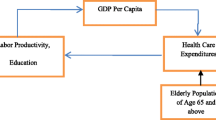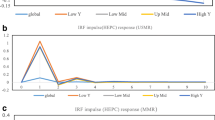Abstract
The objective of the study is to investigate the link between health care expenditures (HCE), economic growth and health outcomes (i.e., life expectancy (LE), infant mortality and the share of elderly people) for a panel of South Asian Association for Regional Cooperation (SAARC) countries; namely, Afghanistan, Bangladesh, Bhutan, India, Maldives, Nepal, Pakistan and Sri Lanka; over the period of 1995–2010. The developed panel cointegration technique is employed for analysis of short and long-run relationship between the variables. The results of panel cointegration found that there is a long-run relationship between health expenditures, economic growth and health outcomes in SAARC region. The estimated results indicate that both, LE and share of elderly people in population have a negative relationship related to the HCEs which signifies that HCEs are luxury goods in SAARC countries. The burden of aging population can be lowered by provision of quality health services and utilization of their experience and knowledge in dynamics of economic development forecasting. Furthermore, there is no significant relationship found between infant mortality rate (IMR) and HCEs which implies that HCEs do not provide sufficient benefits to reduce infant mortality. Similarly, HCEs are not enough in generating GDP, lowering IMR and increasing LE in SAARC region. The implementation of appropriate tax reform, stable food prices and trade promotion for low transaction cost medical equipment is required for the SAARC region.


Similar content being viewed by others
References
Alam, A.Y., Nishtar, I.S., Amjad, S., Bile, K.M.: Impact of wealth status on health outcomes in Pakistan. East. Mediterr. Health J. 16(1), 152–158 (2010)
Annual Health Bulletin: Royal Government of Bhutan. Ministry of Health, Thimpu (2007)
Anyanwu, J.C., Erhijakpor, A.E.O.: Education expenditures and school enrolment in Africa: illustrations from Nigeria and the other SAWE Countries. Paper presented at the 50th Anniversary and Annual Conference of the Nigerian Economic Society, Abuja, Nigeria (2007)
Banerjee, A.: Panel data unit roots and cointegration: an overview. Oxford Bulletin of Economics and Statistics S1(61), 607–629 (1999)
Baltagi, B.H., Moscone, F.: Health Care Expenditure and Income in the OECD Reconsidered: Evidence from Panel Data. Discussion Paper No. 4851, pp. 1–24 (2010)
Breitung, J.: The local power of some unit root tests for panel data. In: Baltagi, B. (ed.) Non-stationary panels, panel cointegration, and dynamic panels (Advances in Econometrics vol. 15), pp. 161–178, JAI Press, Amsterdam (2000)
Bukhari, S.A.H., Butt, M.S.: The direction of causality between healthcare spending and GDP. The case of Pakistan. Pak. Econ. Soc. Rev. 45(1), 125–140 (2007)
Castle, K., Duberstein, P.R., Meldrum, S., Conner, K.R., Conwell, Y.: Risk factors for suicide in blacks and whites: an analysis of data from the 1993 National Mortality Followback Survey. Am. J. Psychiatry. 161, 452–458 (2004)
Fare, R., Grosskopf, B., Lindgren, B., Poullier, J.: Productivity Growth in healthcare delivery. Med. Care. 35, 354–366 (1997)
GDF: Global Development Finance (GDF), World Bank. http://databank.worldbank.org/ddp/home.do?Step=12&id=4&CNO=2 (2011). Accessed 19 Mar 2012
Hadri, K.: Testing for stationarity in heterogeneous panel data. Econom. J. 3(2), 148–161 (2000)
Haq, A.: SAARC-2005–2008. IPRI Fact file. pp. 1–115 (2008)
Health care: India Brand Equity Foundation. http://www.ima-india.org (2011). Accessed 17 May 2012
Health panel: Health Panel-People’s SAARC. Sirilanka, pp. 1–22. http://www.thesouthasian.org/archives/archives/2008/saarc.pdf (2008). Accessed 7 June 2012
Hossain, K., Islam, R., Chowdhury, Q.H.: Socio-economic and demographic correlates of infant and child mortality: the case of slum areas in Rajshahi district of Bangladesh. Int. J. Prev. Treat. 1(1), 11–17 (2012)
Im, K.S., Pesaran, M.H., Shin, Y.: Testing for unit roots in heterogeneous panels. J. Econom. 115(1), 53–74 (2003)
Issa, H., Ouattara, B.: The effect of private and public health expenditure on infant mortality rates: does the level of development matters? Available from: http://www.swan.ac.uk/economics/dpapers/2005/0502.pdf (2005). Accessed 20 Sept 2012
Jain, A.: Advancements in preventive health care and impact on social perception in SAARC countries. SAARC J. Hum. Resour. Dev. 1(1), 118–142 (2005)
Kao, C., McCoskey, S.: A residual-based test of the null of cointegration in panel data. Econom. Rev. 17(1), 57–84 (1998)
Levin, A., Lin, C.F.: Unit root tests in panel data: asymptotic and finite-sample properties. Mimeo. San Diego: University of California (1992)
Levin, A., Lin, C.-F.: Unit root tests in panel data: new results. Department of Economics, University of California (1993)
Levin, A., Lin, C.F., Chu, C.S.: Unit root tests in panel data: asymptotic and finite sample properties. J. Econom. 108, 1–24 (2002)
Maldives Ministry of Health.: Statistical Year Book: Ministry of Planning and National Development, Maldives (2005)
Mark, N.C., Sul, D.: Cointegration vector estimation by panel DOLS and long-run Money Demand. NBER Technical Working Paper. p. 287 (2002)
McIntosh, C. (2006) The relationship between healthcare provision and AIDS prevalence in sub-saharan Africa, pp. 1–28. http://su.diva-portal.org/smash/get/diva2:190004/FULLTEXT01. Accessed 9 July 2012
Mehrara, M., Musai, M., Amiri, H.: The relationship between health expenditure and GDP in OECD countries using PSTR. Eur. J. Econ. Finance Adm. Sci. 8(24), 1–9 (2010)
McWilliams, J.M.: Health Consequences of uninsurance among adults in the United States: Recent evidence and implications. Milbank Q. 87(2), 443–494 (2009)
Mishra, S.K.: Indian Demography and Health Delivery. http://www.sgpg-telemedicine.org (2008). Accessed 29 July 2012
Munsur, A.M., Atia, A., Koffi1, A.K., Kawahara K.: Household out-of-pocket expenditures on health care in Bangladesh according to principal component analysis (PCA). Bio Sci. Trends 3(1), 25–31 (2009)
Pedroni, P.: Critical values for cointegration tests in heterogeneous panels with multiple regressors. Oxford Bulletin of Economics and Statistics, Special Issue, vol. 61, pp. 653–670 (1999)
Pedroni, P.: Purchasing power parity tests in cointegrated Panels. Rev. Econ. Stat. 83(4), 727–731 (2001)
Pedroni, P.: Panel cointegration: asymptotic and finite sample properties of pooled time series tests with an application to the PPP hypothesis. Econom. Theory 20, 597–625 (2004)
Phillips, P., Perron, P.: Testing for a unit root in time series regression. Biometrica 75(3), 335–346 (1988)
Phillips, P.C.B.: Fully modified least squares and vector autoregression. Econometrica. 63, 1023–1078 (1995)
Penas, S.L., Prieto, D.C., Fernandez, C.B.: On the Relationship between GDP and Healthcare Expenditure. A New perspective: Social Science Research Network (Instituto de Estudios Fiscales Working Paper No. 4/2012), pp. 1–22. http://papers.ssrn.com/sol3/papers.cfm?abstract_id=2033692 (2011). Accessed 5 Aug 2012
Prieto, D., Lago-Peñas, S.: Decomposing the determinants of health care expenditure: the case of Spain. Eur. J. Health. Econ. 13(1), 19–27 (2012)
Saikkonen, P.: Asymptotically efficient estimation of cointegration regressions. Economet. Theor. 7, 1–21 (1991)
Schoder, J., Zweifel, P.: Flat-of-the-curve medicine: a new perspective on the production of health. Health Econ. Rev. 1(2), 1–10 (2011)
Selvaraju, V., Wangmo, S., Wangchuk, U., Dendup, T.: Bhutan National Health Accounts: 2009–10, pp. 1–18. Policy and Planning Division, Ministry of Health, Royal Government of Bhutan, Thimpu (2011)
Shakya, K.: Relationship between Human Resource Development & Per Capita Income in the SAARC Countries, pp. 1–15. http://www.shrdc.org/sjhrd2008.php (2004). Accessed 19 Aug 2012
Silvestre, J.L.C.: Health care expenditure and GDP: are they broken stationary? J. Health Econ. 24(5), 839–854 (2005)
Sirgy, M.J., Kruger, P.S., Lee, D.J., Yu, G.B.: How does a travel trip affect tourists’ life satisfaction? J. Travel. Res. 50(3), 261–275 (2011)
Statistical Year Book: Ministry of Planning and National Development. Statistical Year Book, Maldives (2006)
Stock, J.H., Watson, M.W.: A simple estimator of cointegrating vectors in higher order integrated systems. Econometrica. 61, 783–820 (1993)
Tchoe, B., Nam, S.H.: Aging Risk and Health Care Expenditure in Korea. International Journal of Environmental Research and Public Health. http://www.mdpi.com/journal/ijerph (2010). Accessed 12 Sep 2012
UN: Indicators for Monitoring the Millennium Development Goals: Definitions, Rationale, Concepts and Sources. United Nations, New York (2003)
UN: The United Nations Development Agenda: Development for All. Goals, commitments and strategies agreed at the United Nations world conferences and summits since 1990. United Nations, NewYork (2007)
UNDP: Human Development Report. Afghanistan. www.hdr.undp.org/reports/global/2008/ (2008). Accessed 19 July 2012
UNICEF: The State of the world’s Children, 2008. United Nations Children’s Fund, USA (2008)
United Nations: Population Data Sheet 2008. ESCAP, Thailand (2008)
UNSD: United Nation Statistics Division. http://unstats.un.org/unsd/default.htm (2010). Accessed on 19 June 2012
WDI: World Development Indicator, World Bank. http://databank.worldbank.org/ddp/home.do?Step=12&id=4&CNO=2 (2011) Accessed 19 Mar 2012
Westerlund., Joakim.: A panel data test of the bank lending channel in Sweden. Working Papers 2003:16. Department of Economics, Lund University (2003)
WHO: Human resources for health. Bhutan. http://www.searo.who.int/en/Section313/Section1517_10767.htm (2006). Accessed 19 June 2012
WHO: World Health Report, 2006, pp. 1–55. National Health System Profile, Bhutan (2006)
WHS: World Health Statistics. http://www.who.int/countries/ind/en/ (2009). Accessed 19 April 2012
World Health Statistics (WHS): World health statistics annual report. http://www.who.org (2009). Accessed 19 June 2012
Zakir, M., Wunnava, P.V.: Factors affecting infant mortality rates: evidence from cross-sectional data. Appl. Econ. Lett. 6(3), 271–273 (1999)
Author information
Authors and Affiliations
Corresponding author
Rights and permissions
About this article
Cite this article
Hassan, S.A., Zaman, K., Zaman, S. et al. Measuring health expenditures and outcomes in saarc region: health is a luxury?. Qual Quant 48, 1421–1437 (2014). https://doi.org/10.1007/s11135-013-9844-2
Published:
Issue Date:
DOI: https://doi.org/10.1007/s11135-013-9844-2




